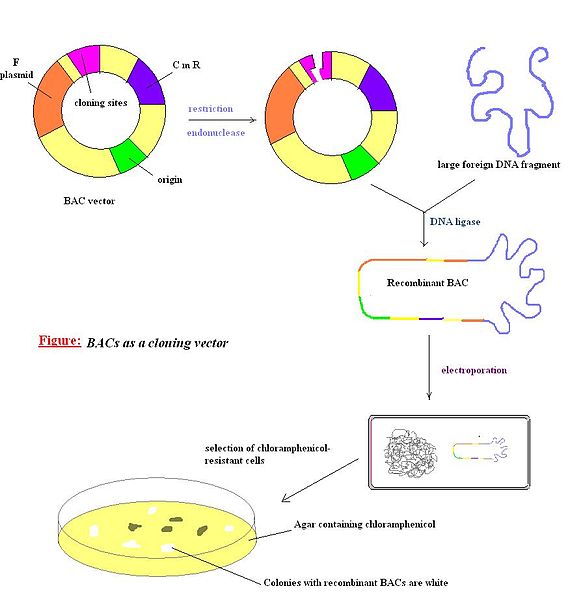Difference Between YAC and BAC Vectors
Key Difference – YAC vs BAC Vectors
Vectors are used in molecular cloning. A vector can be defined as a DNA molecule which behaves as a vehicle to carry foreign genetic material into another cell. A vector containing foreign DNA is known as recombinant DNA and it should have the capability of replicating and expressing it within the host organism. Yeast artificial chromosome (YAC) and bacterial artificial chromosome (BAC) are two types of vectors involved in cloning. The key difference between YAC and BAC is that YAC is an artificially constructed vector system using a specific region of yeast chromosome to insert large segments of genetic materials to yeast cells while BAC is an artificially constructed vector system using a specific region of E. coli chromosome to insert large segments of DNA into E. coli cells.
CONTENTS
1. Overview and Key Difference
2. What are YAC Vectors
3. What are BAC Vectors
4. Side by Side Comparison – YAC vs BAC Vectors
5. Summary
What are YAC vectors?
YAC (Yeast artificial chromosome) is an artificially built chromosome which has the ability to carry a large segment of foreign DNA and replicate within the yeast cells. It has a centromere, telomeres as well as autonomously replicating sequences that are essential for replication and stability. YAC should also bear a selective marker or markers and restriction sites to make it an effective cloning vector. A large sequence ranging from 1000 kb to 2000 kb can be inserted into YAC and transferred into yeast. The transformation efficiency of YAC is very low.

Figure 01: YAC Vector
What are BAC Vectors?
Bacterial artificial chromosome (BAC) is an artificially constructed chromosome for molecular cloning. It has specific regions of E. coli F plasmid and it’s circular and super coiled. BAC is developed to clone DNA fragments to bacteria, especially to E. coli. It can bear DNA fragments having sizes up to 300 kb. Compared to YAC, BAC cloning inserts are smaller in sizes. BACs were developed in 1992 and it is still popular due to its stability and ease of construction. BACs are also useful in developing vaccines.

Figure 02: BAC Vector in molecular cloning
What is the difference between YAC and BAC Vectors?
YAC vs BAC Vectors | |
| YAC is a genetically engineered chromosome with the use of yeast DNA for the purpose of cloning. | BAC is a genetically engineered DNA molecule using E. coli DNA for the purpose of cloning. |
| Gender | |
| YACs were designed to clone large fragments of genomic DNA into yeast. | BACs were developed for cloning large genomic fragments into Escherichia coli. |
| Insert Length | |
| YACs can contain megabase-sized genomic inserts.(1000 kb – 2000 kb). | BACs can carry inserts of 200–300 kb or less. |
| Construction | |
| YAC DNA is difficult to purify intact and requires high concentration for generating YAC vector system. | BAC is easy to purify intact and can be easily constructed. |
| Chimerism | |
| YACs are often chimeric. | BACs are rarely chimeric. |
| Stability | |
| YAC is unstable. | BAC is stable. |
| Modifications | |
| Yeast recombination is very feasible and always remains active. Hence it can generate deletions and other rearrangements in a YAC. | E. coli recombination is prevented and is turned on when required. Hence, it reduces the unwanted rearrangements in BACs. |
| Maintenance | |
| Manipulating recombinant YACs usually requires YAC to be transferred into E. coli for subsequent manipulation. Hence, it is a laborious process. | BAC modification occurs directly in E. coli. So there is no need for DNA transfer. Hence, the process is not laborious. |
Summary – YAC vs BAC Vectors
YAC has become an essential research tool in cloning processes due to its ability to clone large fragments of DNA into the host organism. However, YACs have several disadvantages as vectors such as construction difficulties, chimerism, instability, etc. Therefore to overcome these problems, scientists have developed BAC vectors. BAC has been constructed using specific regions of E. coli chromosome. It is a stable vector and can easily be constructed. However, the length of DNA that BAC can handle is up to 20 times less than that of YAC. This is the difference between YAC and BAC vector systems. Nowadays, BAC is more preferred over YAC in the labs.
References
1. Shero, J. H., M. K. McCormick, S. E. Antonarakis, and P. Hieter. “Yeast artificial chromosome vectors for efficient clone manipulation and mapping.” Genomics.U.S. National Library of Medicine, June 1991. Web. 25 Mar. 2017
2. Ramsay, M. “Yeast artificial chromosome cloning.” Molecular biotechnology. U.S. National Library of Medicine, Apr. 1994. Web. 25 Mar. 2017
Image Courtesy:
1.“BACs cloning vectors Chem114A” By Tinastella – (CC BY-SA 3.0) via Commons Wikimedia
ncG1vNJzZmivp6x7pbXFn5yrnZ6YsqOx07CcnqZemLyue8OinZ%2Bdopq7pLGMm5ytr5Wau27FwJxkmqaUYsO0ecGammaulZjBsL7SaA%3D%3D